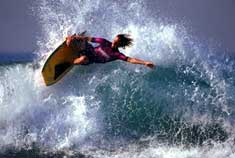Remember Endless Summer? Bruce's Beauties? Well, that's just one of the incredible breaks on our coast. The best known surfing spots are around Cape Town, Durban, Jeffreys Bay and East London, but there are loads of great, virtually unsurfed waves.
The many backpackers hostels around the country are geared up for board rental, escorted surfaris and surfing lessons, and there are dedicated surf schools in Durban and Cape Town.
We have awesome windsurfing and kitesurfing spots. Langebaan, near Cape Town, is internationally recognised to be one of the top boardsailing venues in the world - and there are others.
A more accessible way to experience the sea is in a specially designed sea kayak. There are escorted trips around Cape Town, Hermanus, Knysna, Plett and Durban.
For a bit more of a challenge, try surfskiing - it's becoming a rather trendy pastime and can be very competitive. Surfskis are really fun boats to paddle - fast, responsive and with the approximate stability of a razor blade balanced on its edge. There is a whole series of races throughout the year all along the coast. Check out www.surfski.co.za.
The South African coastline is one of the most challenging in the world to sail, with few harbours, stormy conditions and, often, very rough seas. So it's not a good bareboat option. However, it's a great place to learn to sail - there are sailing schools in Cape Town, Port Elizabeth and Durban - and we feature on all the major round-the-world races. There are loads of local races, too, and the Cape to Rio is one of the most accessible ocean crossing races in the world, attracting a large cruising contingent.
If you need any convincing about the seriousness of our coast, you need look no further than the many historical and recent shipwrecks. Of course, these were all tragedies but still good news for local divers. We have more to offer than these poignant sites, though. Our underwater environment is absolutely beautiful and varied and we have lots of wonderful diving sites.
We have an enormously long coastline ranging from about 35°S to 27°S, which isn't quite within the usual range of tropical diving. However, the Mozambique Current which flows down our East Coast brings warm, tropical water with it, and at Sodwana Bay we have the most southerly coral reefs in the world. Of course, they have the full complement of pretty colourful fish and some great nudibranchs, including the outrageous Spanish dancer (Hexabranchus sanguineas). Whale sharks, turtles, dolphins and ragged tooth sharks (Carcharias taurus) are often seen in specific places.
And then, as you head down the coast, the underwater faunal and floral assemblage changes gradually until, once you've reached Cape Town, you're diving in chilly but beautiful kelp forests. These, too, are unique. There are three major types, or genera, of kelp and it is only off a short portion of the Western Cape coast that they all grow together.
If you've always shunned cold water diving, consider it. Sure, you do have to dress up in a great thick wetsuit with constraining hoodie and gloves but it's worth it. Diving in kelp is like walking in a forest. You float beneath the canopy and admire the surprisingly colourful reef life. Off Cape Town, divers regularly see anemones in colours ranging from electric blue or deep red to pale pink, nudibranchs of almost every colour you can imagine and a whole range of small creatures in and around the bright orange and sulphur yellow sponges.
There are dive schools in almost every centre, with a surprising number in the landlocked Johannesburg area. Perhaps it's not so surprising. Most people do their training up there and then head down to Sodwana Bay for their qualifying dives.
There is even an inland dive resort near Johannesburg where students can do their first dive or two in a disused quarry. Badgat is another, much deeper disused quarry in Mpumalanga where rebreather, mixed gas and deep diving courses are run.
When you come here to dive our wonderful reefs, do take careful note of your no-fly limits. A flight from sea level to Johannesburg can take only an hour, and you gain 2 000m (7 000ft) in altitude - that's without even considering the flight. This really does represent a major risk, so adjust your itinerary to include a day of sightseeing, shopping or beach lounging between diving and flying or even driving to Johannesburg.
Source: South African Tourism








